On April 9th, 1940, Hitler unleashed his military machine on Norway, breaking that country's neutrality and overwhelming the unprepared defenders at cities including Oslo, Kristiansand, Stavangar, Bergen and Trondheim using troops carried aboard warships. The British had their fleet in the North Sea, and Renown had fought Scharnhorst and Gneisenau off the mouth of the fjord leading into the strategic city of Narvik, but the Germans had gotten 10 destroyers into the town ahead of them. The first attempt to drive the Germans out with a destroyer force had failed with casualties on both sides, but on April 13th, the British returned to try again with a heavier force.
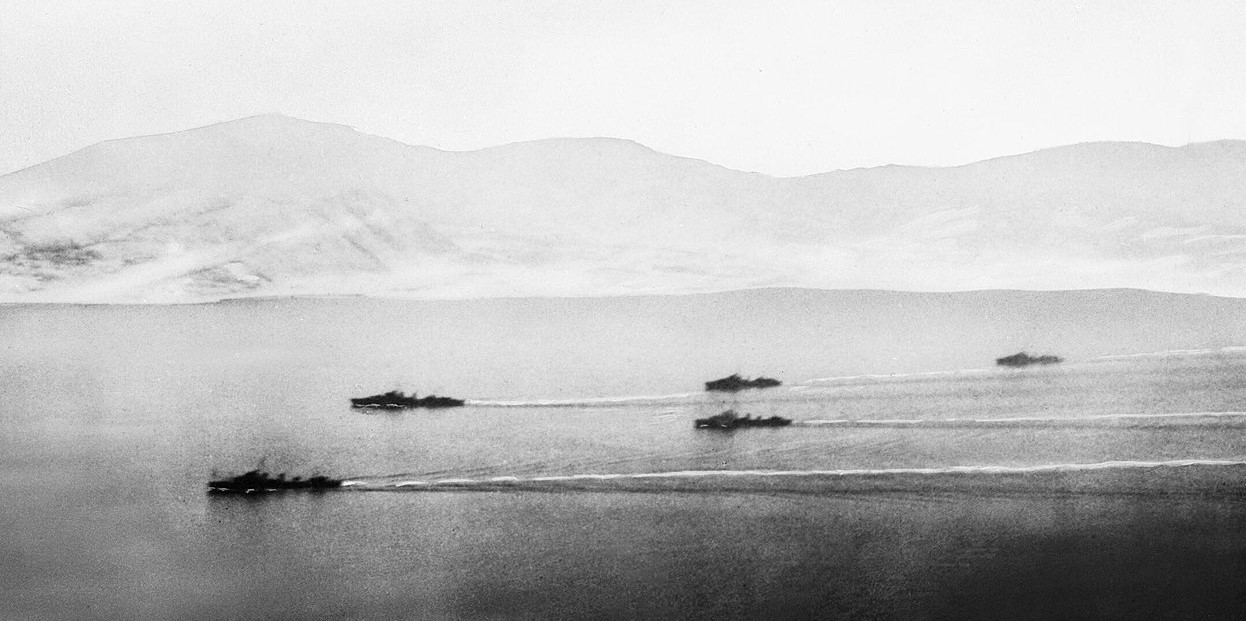
British destroyers approach Narvik for the second time
Despite the imagined risk of coastal guns and mines, this force would be built around the battleship Warspite, escorted by nine destroyers. The very real risk posed by five U-boats in the area was almost entirely ignored, even after the force ran across U48 at the entrance to the Ofotfjorden. Destroyer Eskimo depth-charged the submarine without success, and her crew recovered in time to fire a full salvo of torpedoes at Warspite, but without success.1 A second submarine, U46, managed to slip undetected inside the destroyer screen, but ran aground just before firing and missed her opportunity.
Just before noon, Warspite flew off her Swordfish, sending it to scout up the fjord. Minutes after takeoff, the crew spotted two German destroyers, Kunne escorting the damaged Koellner to be grounded as a floating battery and warning post for when the British showed up. Kunne quickly turned back, screening herself with patches of fog and rain. The rest of the German force made preparations to respond, but the signal to the accompanying U-boats was unclear, and two of the boats dived to avoid air attack while U64 hesitated to repair a periscope problem. The delay proved fatal when the Swordfish caught her on the surface, landing a pair of bombs on the submarine and opening her hull. The crew quickly evacuated as the submarine heeled over, while the British plane confirmed that the rest of the German destroyers were still in Narvik harbor before turning back to search ahead of the advancing surface ships.
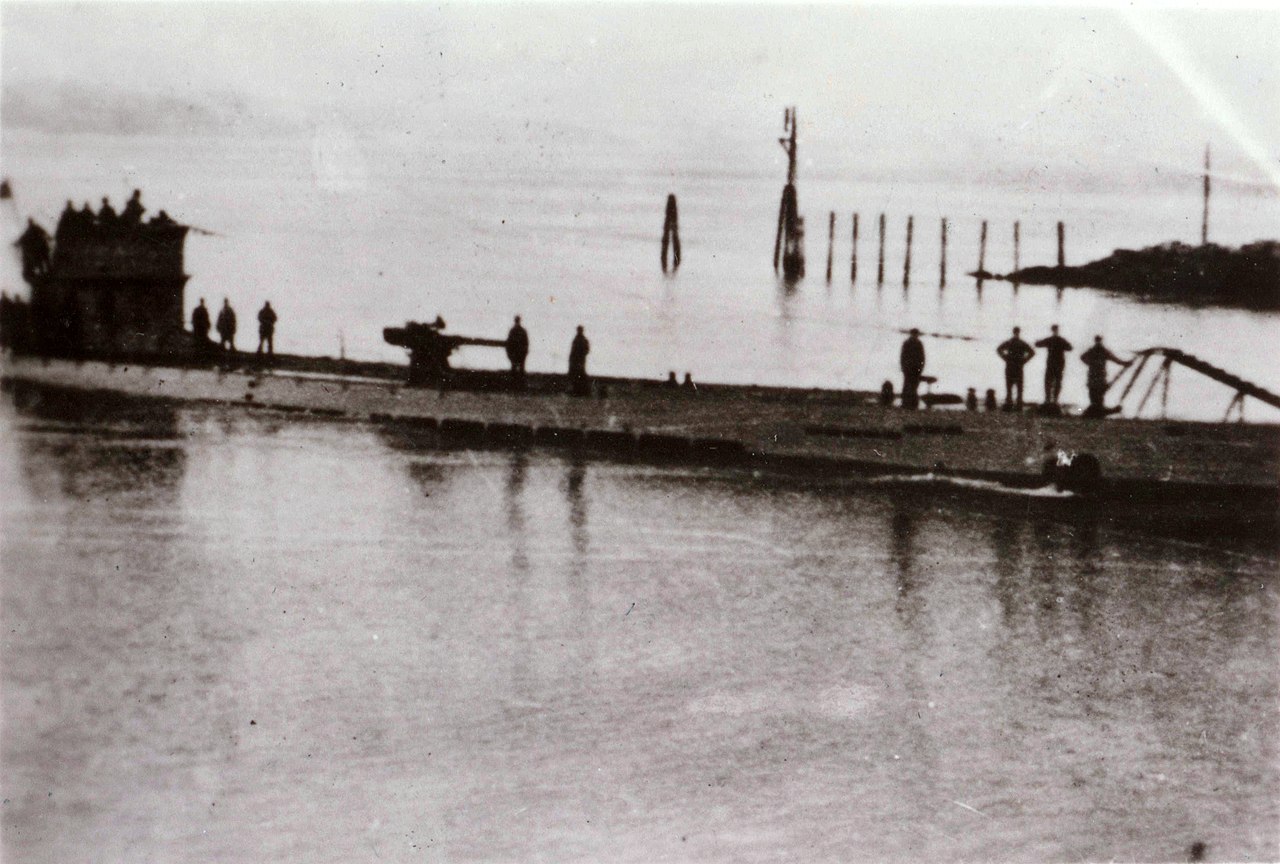
A U-Boat in Narvik harbor
The first victim of the British was Koellner, whose captain attempted to ambush the British even though he had lost his torpedoes before being dispatched to serve as a stationary battery. This attempt was foiled by the Swordfish, and when Bedouin, Punjabi and Eskimo came into view, they opened fire with both main guns and Pom-poms, doing terrible damage to the German ship. Her return fire was ineffective, and her fate was sealed when Warspite came into range. Her 15" SAP shells tore through the unarmored destroyer without exploding, but each impact visibly rocked Koellner. A torpedo finally sent her to the bottom, and most of her crew was picked up by Norwegians ashore.
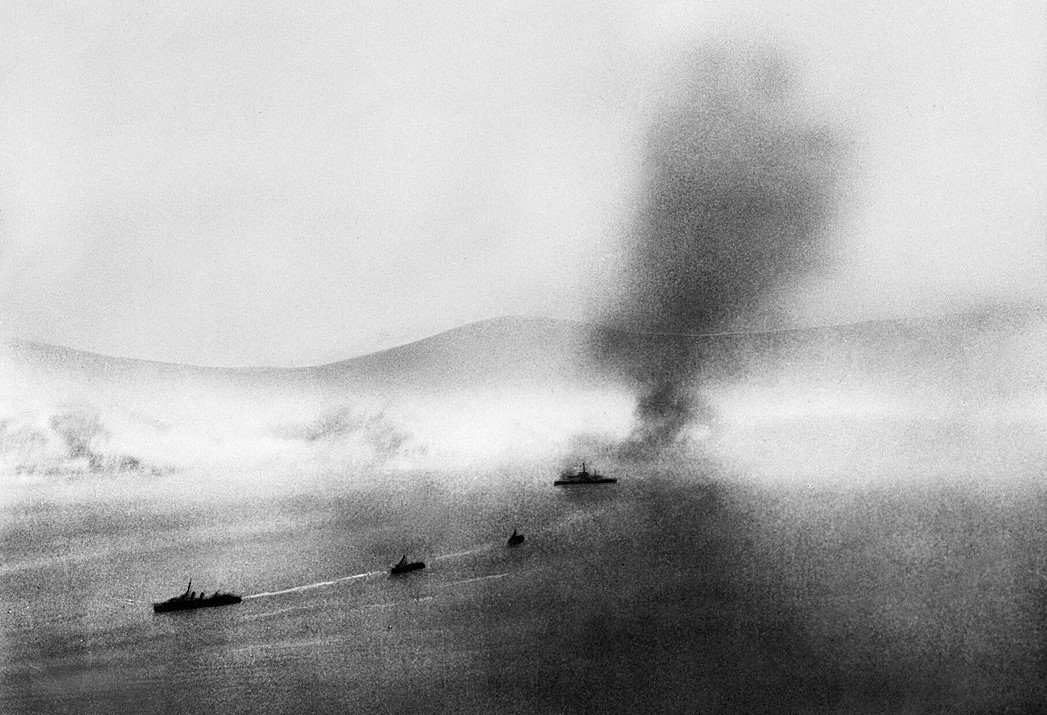
Warspite and destroyers engage the enemy
Five of the hale German destroyers sortied from Narvik to oppose the British, and the two sides began to engage each other at relatively long range. The weather had begun to clear, but the hour-long engagement that followed saw no hits on either side thanks to smoke and the lack of fire-control equipment on the destroyers. The Germans tried several times to launch torpedo attacks, but one by Arnim on Warspite was driven off by the combined fire of the battleship and her escorts, and another saw at least one torpedo pass underneath Coassack without detonating. U25, driven down by the Swordfish, also tried to enter the battle, but her torpedoes failed to find their targets. Warspite herself took part in the battle, the noise from her guns setting off avalanches on the mountains around the fjord, but her projectiles failed to find the swerving destroyers. Midway through the battle, nine Swordfish from Furious appeared, but they scored no hits and two were shot down.
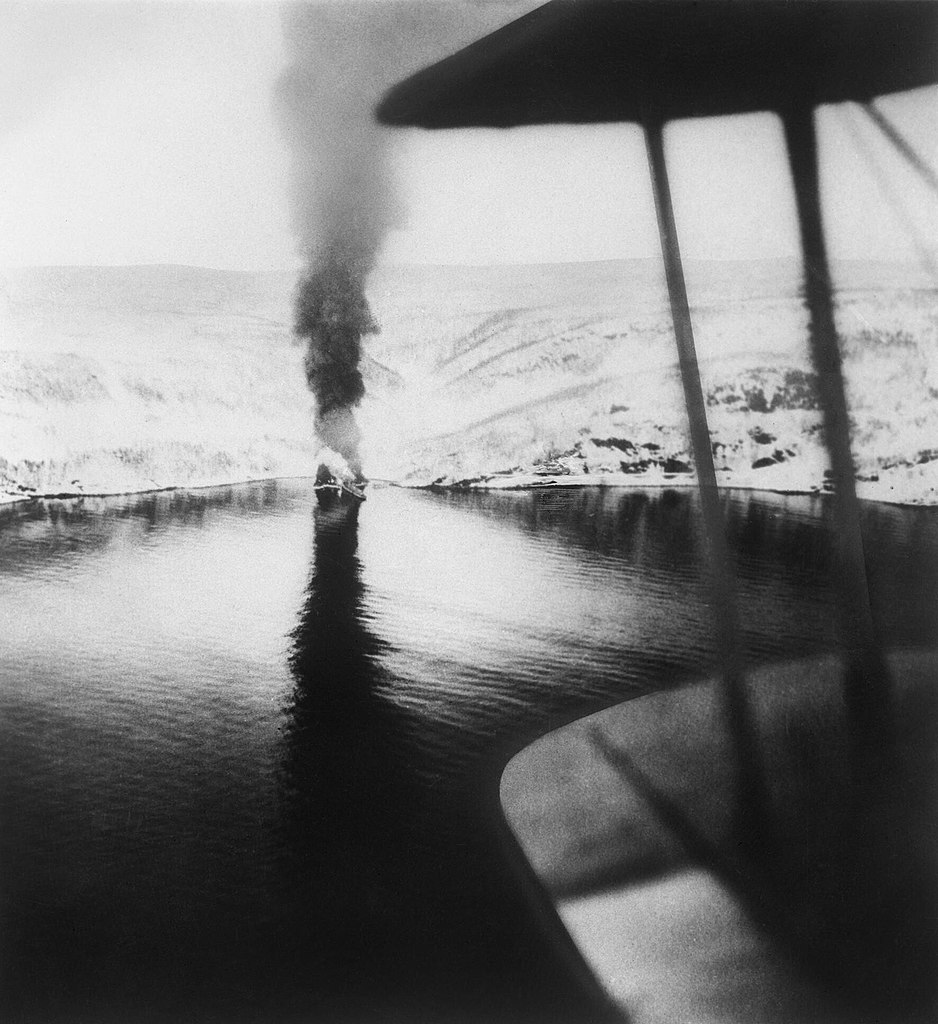
Kunne burns after being scuttled
The battle was finally brought to an end by the dwindling ammunition reserves of the German destroyers, their magazines already depleted by the action three days earlier. Kunne had fired off every single round onboard, even the practice and star shells, before she beached herself and her crew set the scuttling charges. The other four ships withdrew down a different arm of the fjord, where two, completely out of ammo, beached themselves while the other two, Thiele and Ludemann, prepared to make a last stand with what they had left.
That just left two destroyers, Giese and Roeder, which hadn't managed to get underway in time to participate in the battle outside Narvik Harbor. Giese, low on ammunition but largely undamaged, sortied just as the other destroyers withdrew, intending to use her torpedoes against the British. This plan was thwarted when her engines, still suffering problems from the journey to Narvik, seized up, leaving her dead in the water. A brief skirmish with Bedouin and Punjabi saw both sides miss with their torpedoes and the German destroyer pump half a dozen shells into Punjabi, putting guns out of action and breaching the main steam pipe. Bedouin then closed in as Giese's engines were repaired, turning the German destroyer into a blazing wreck that took 83 men down with her.
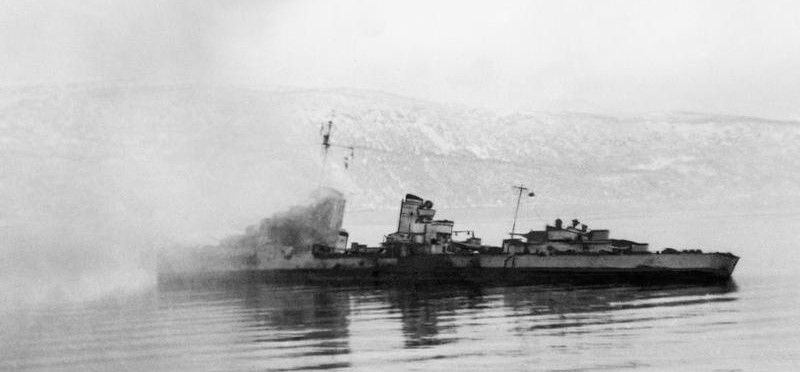
A German destroyer burns after the battle
Roeder, badly damaged during the skirmish on the 10th, was still moored inside the harbor, her crew firing on any British ships they could see, first Punjabi and Bedouin during the engagement with Giese and then Warspite. The British believed the fire was from shore batteries until the Swordfish overhead alerted them to the destroyer's presence, and Cossack and Kimberly were sent to investigate. Cossack finally sighted Roeder at short range and the two ships pummeled each other, with Cossack taking enough hits to put both engines and steering gear out of action. The British destroyer, out of control, ran aground, while the German gunners remaining onboard Roeder decided it was time to abandon the ship and set the scuttling charges. Cossack's crew fought their fires and put the engines back online, but soon discovered that their ship was well and truly stuck, and they'd have to wait for the next high tide to pull her off. That would be the next morning, and the destroyer would spend the night beached 50 meters from the German-controlled shore. Codebooks and secret documents were destroyed in case the Germans tried something, and unnecessary equipment was thrown overboard to lighten the ship. Snipers and mortar fire harrassed the crew, although the main guns dealt with the former and the pom-poms the later, and Cossack freed herself the next morning and headed for the repair base at Skjelfjord.
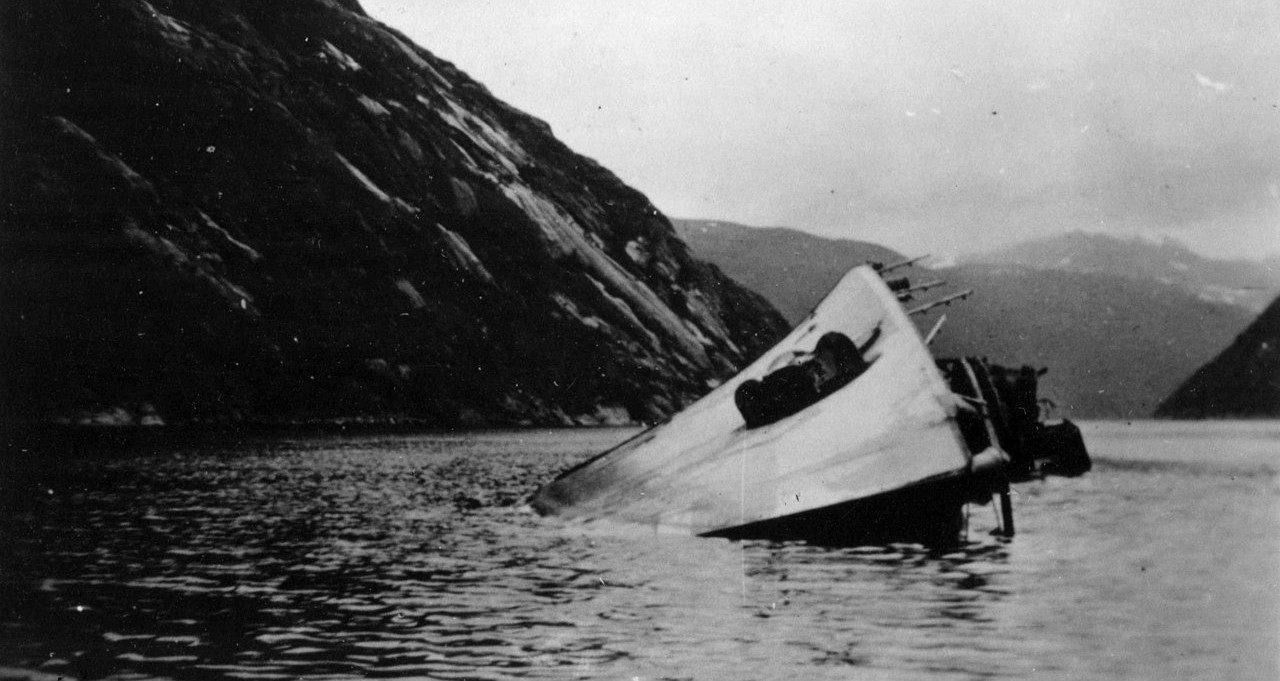
One of the scuttled German ships
That just left Thiele and Ludemann, which the British sent Eskimo and Forester to deal with. Ludemann sighted them first, opening fire at about 3 miles, but the British gunners were better, and soon put the German ship's guns out of the fight. Ludemann withdrew up the fjord, covered by Thiele, but not before launching her torpedoes. They were ineffective, but Eskimo was forced to dodge, leaving her flat-footed with Thiele’s torpedoes arrived moments later. The German torpedoes, ineffective so often throughout the battle around Narvik, finally came good, with the single hit taking off the bow back to number one turret. But this wasn't enough to save Thiele from a severe pounding at the hands of Forester, Eskimo’s remaining guns and the late-arriving Hero and Icarus. Eventually, the burning wreck was run aground by her crew, but her last stand had bought enough time for the other three destroyers to be evacuated in an orderly manner, with supplies and equipment taken ashore before the ships were scuttled. These supplies, and the ship's crews, provided a welcome boost to the German troops occupying Narvik. Eskimo's crew did a magnificent job of damage control, shoring up the bulkheads and managed to back their ship to the repair base at Skjelfjord.
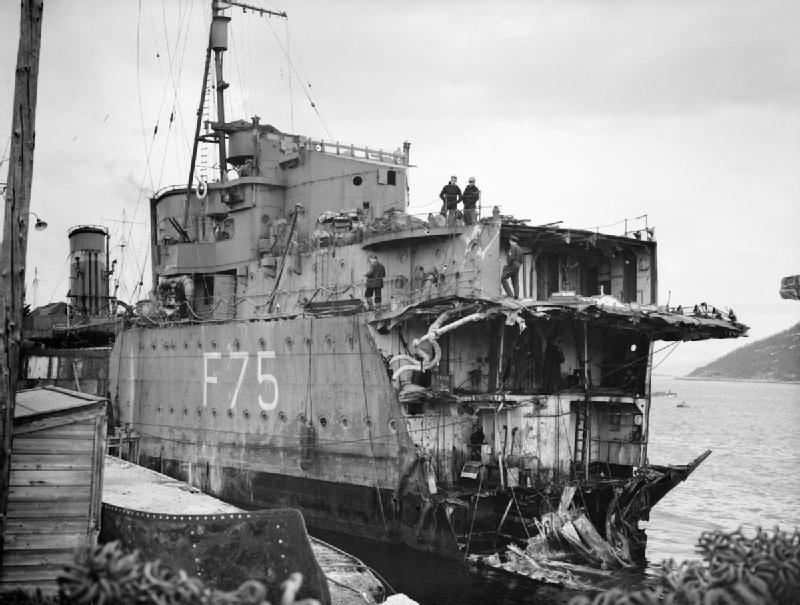
Eskimo's bow, or lack thereof
Tactically, the action around Narvik was a major victory for the British. Despite their losses, they had broken the back of the German destroyer force for the rest of the war. But there were still German troops ashore, and the British decided to withdraw Warspite due to the risk of air and submarine attack. The action off Narvik was the last clash in the opening stage of the battle for Norway. The Germans were now safely ashore, and Britain, France and Norway were all scrambling to respond.
1 While the problems of American submarine torpedoes are justly famous, this was not a problem suffered only by the USN, and German torpedoes suffered from a lot of issues through 1941. ⇑

Comments
Footnote https://www.navalgazing.net/Norway-Part-12#fn1_1 is missing
Warspite doesn't seem to have actually done very much?
She did not. I meant to mention that in the thread on the last post, but got distracted.
I wonder if Tom Clancy and /or Larry Bond were aware of Eskimo when they wrote Red Storm Rising?
She's not the only ship to have lost her bow. Probably the most famous case is Pittsburgh (bad welding, not battle damage), but it also happened to Minneapolis at Tassafaronga. Those are the only ones I can place offhand, but I'm sure it happened a lot more than that.